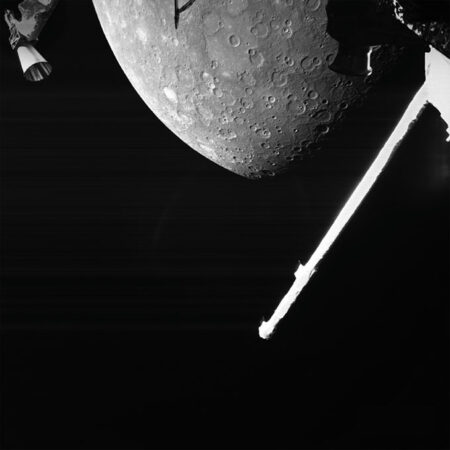A rain of electrons causes Mercury’s X-ray auroras
Mercury’s auroras are perfectly in character. While temperate Earth gets heavenly light shows over its poles, hellish Mercury gets invisible ribbons of X-ray radiation that cling to its sun-blasted surface.
But as alien as they may appear, Mercury’s X-ray auroras have a lot in common with Earth’s polar lights, and with auroras throughout the solar system.
Scientists have now directly shown that fluctuations in Mercury’s magnetic field can fling electrons toward the planet, where they eventually rain down and cause auroras of X-ray light. This process, called electron precipitation, now appears to be practically universal in the solar system: It causes auroras on every planet with a global magnetic field except Neptune, researchers report July 18 in Nature Communications. Even Mars, which has only localized magnetic fields, has auroras caused by raining electrons (SN: 3/19/15).
For Mercury, “this is really the first time to detect these electrons directly,” says space plasma physicist Sae Aizawa of the University of Pisa in Italy.
Electron precipitation usually happens because of interactions between planets’ magnetic fields and the solar wind — a stream of charged particles spewed from the sun’s upper atmosphere.
Buffeted by the solar wind, the sun-facing side of a planet’s magnetic field gets squished while the night side is swept out into a long “magnetotail” that extends behind the planet. Eventually, the magnetotail stretches so much that its formerly mostly-parallel magnetic field lines snap and reconnect, sending some field lines flying off behind the planet and others back toward it.

“The magnetic field lines sort of break and form new ones,” says space physicist Ryan Dewey of the University of Michigan in Ann Arbor, who was not involved in the study. “And in that process, a lot of energy is released.”
All that energy sends packets of electrons flying planetward, spiraling in corkscrew-like trajectories along magnetic field lines. When these electrons hit the planet or its atmosphere, they release energy as light.
The light’s wavelength depends on what the electrons encounter as they rain down. Earth’s auroras shine in visible wavelengths because incoming electrons excite molecules of uncharged gases in the atmosphere like oxygen and nitrogen, which release visible light when they relax back to their normal states. Mercury’s auroras shine in X-ray wavelengths because electrons decelerate as they smack the planet’s rocky surface. The lost energy is released as X-rays.
Researchers first spotted Mercurian X-ray auroras in data beamed back from the MESSENGER probe, which orbited Mercury from 2011 to 2015 (SN: 4/30/15). But while scientists reasoned that electrons must rain down on Mercury to cause its X-ray glow, MESSENGER didn’t have the right instruments to measure the precipitating particles.
The European Space Agency’s BepiColombo spacecraft does. Analyzing data from the probe’s first flyby of Mercury in 2021, Aizawa and her colleagues spotted telltale signs of the process.
One clue was that as BepiColombo flew through Mercury’s magnetosphere, it observed surges of fast-moving, high-speed electrons followed by several subsequent waves of progressively slower, lower-energy electrons. “This is exactly what we’d describe as a precipitating signature,” says Aizawa, who did the work while at the Institute of Research in Astrophysics and Planetology in Toulouse, France.
To Dewey, the new discovery is a tantalizing sneak peek at the discoveries waiting to be made at Mercury once BepiColombo enters orbit in 2025. By then, it will have been a decade since scientists last had a probe continuously orbiting Mercury.
“To me, it’s very exciting to see just how much we can learn from even just a short pass through the magnetosphere,” he says. “It’s a glimpse.”
For all the latest Technology News Click Here
For the latest news and updates, follow us on Google News.
